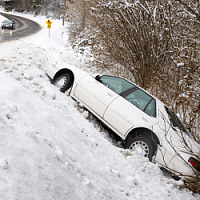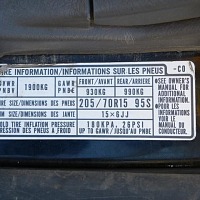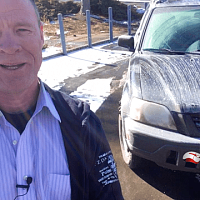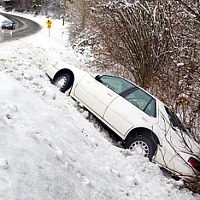
Ensure your vehicle is correctly maintained for harsh winter conditions.
https://www.youtube.com/embedhNWG7Q3_9Bo
How to Prepare Your Vehicle for Winter | Winter Driving Smart
Closed Caption
Introduction
Hi there smart drivers.
Rick with Smart Drive Test talking to you today about prepping your vehicle for winter driving.
We have a special guest on the channel today: Rich de Man.
He's the local neighborhood Mr. Fixit - there isn't too much that Rich can't fix!
He worked for more than a decade for the City of Calgary maintaining their fleet, and he's also rebuilt a couple of vehicles from the ground up.
He's also a red seal welder.
So very handy -a nice guy to have around in the neighborhood, especially for those you don't know one end of a screwdriver from the other.
So today Rich is going to give us an overview of things that you need to do to prep your vehicle for winter driving.
So without further ado, we're going to hand it over to Rich.
Alright Rick, a lot of things that people overlook when getting their car prepped for winter.
I'm going to just go through the engine compartment and point out a few of the items that people all too often take for granted and go undone.
[OPENING CREDITS & MUSIC]
Under the Hood
So Rick, I'm going to start with the cooling system.
This vehicle doesn't have a capped radiator system; it has a cap-less radiator.
So in which case the place to check your radiator fluid is right at the overflow tank.
Now keep in mind that it is under pressure as well as a radiator.
So you got to be careful that it's not hot when you remove that cap.
That's a great point!
You're going to get a good hot explosion on your hand or your body - it's not a good experience!
Radiator
So this is where we would normally check the rating for our winter months, which basically means that you're checking with a radiator bulb tester - you're checking to see that you're on an adequate rating.
So as the temperature drops down, you want to know that your engine block isn't going to freeze.
On a typical coolant temperature is between -30°C and -35°C (-21°F to -30°F) for your rating.
You know that the cold comes, your engine block isn't going to freeze over.
So that would be in Celsius?
Yes that is in Celsius.
Now another thing while I'm here - we've got your windshield washer fluid.
There's winter rated washer fluid.
You want to make sure you're always topped up.
With slush and snow on the road you never know when you're going to need that.
So you don't want to be out of that.
As we go through the engine compartment, a few key factors keep in mind.
Winter is a lousy time to break down, let alone breaking down when it is nice.
Belts & Hoses
So you want to be sure that all your engine belts - your drive belts are in good condition.
And that they're adjusted - the proper tension.
You've got your hoses - your vacuum hoses.
So just just backing up there Rich, for just moment.
How would somebody know that their belts are the proper tension - like what would be a good indication?
Would they push on it or...?
A good indication is if you go to a section of your drive belt where you've got a long flat stretch.
Okay, and you just physically take your fingertips and you push down.
Put a little pressure on it - you shouldn't have too much deflection.
It should be somewhat taunt.
If you have anywhere between half and inch to an inch, that's way too much.
You want be sure that there's some some pressure there - right! Okay!
If you push on that, it should spring back; it shouldn't have any slack in it whatsoever.
Perfect ok.
Outside of that Rick, we've got our belts...sorry, our our hoses.
You want to be sure that all your hoses are in good condition.
There's no cracking - they're not dry and brittle.
Very important as well with your cooling system.
If that hose can't push water or coolant - if it's cracked, if it's brittle.
You want to be sure that they're in good shape.
As well, not too soft, no broken or loose connectors.
That's a big thing.
Brake Fluid
Over here, your brake fluid.
You want to be sure that you've got the proper brake fluid for your system - Dot 3 is fairly usual.
Some of the newer vehicles are even running Dot 4 & 5.
Okay.
So you want to be sure that you're at an adequate level on your brake fluid.
Now the brake fluid--the master cylinder is going to be up on the firewall for most of these vehicles?
That's very common.
Up on the back on the driver's side.
Yes it will normally be located right where you see this one, directly in front of the steering wheel.
Okay.
Battery
You want to maintain your battery as well.
Nothing worse than having a dead battery on a cold winter morning when you've got to be a work.
You get out there and you've got a dead vehicle.
Okay.
So keep your batteries up to snuff.
Most batteries nowadays are maintenance-free.
So what you want to do is if you have the glory of having a gauge in your vehicle, it'll show as either a voltage gauge or it'll just show as a battery gauge.
Okay.
You can use that as somewhat of an indicator, if you get out your battery's dead.
That's an indication that you're charging system has got an issue.
Okay.
Your batteries not receiving a charge, or it could be as simple as your batteries will no longer accept a charge.
Okay.
So that's that's another key factor that people often take for granted that the battery is just going to keep producing - they're going to keep going.
But all these issues are things that you really want to keep maintained.
Usual oil changes will reveal any of those problems.
Okay.
And if somebody's concerned about their battery and they think that it hasn't been checked in awhile, how could they get that checked to know that it is working if they don't have a volt gauge on their dash or those types of things?
Battery Tester
Okay, any of your local automotive shops, the fellows even at your speedy oil change centres, they'll have the battery tester.
Okay.
A hydrometer.
Yeah so they'll check with a hydrometer and also they will go over your charging system to be sure that your belts are tight and that they're providing proper charge.
Okay, perfect.
So that's underneath the engine - is there anything that we should do outside of the vehicle - the body?
Tire Air Pressure
There is - one key thing, any time of year let alone it being winter coming around the corner, you want to maintain proper tire pressure.
Okay, very important in how your vehicle is controlled while it's being driven.
If your tires are too low or too hard that vehicle isn't going to respond the way it normally would if the pressures are adequate.
Okay so we'll start with a spare tire here.
We've got the vehicle's spare tire.
Now quite often, you'll notice that somewhere around the tire it's going to show all the information that applies: the size, and as well, most importantly your tire pressure.
So if you look anywhere around the writing it will usually be in fine print - it will tell you what the tires adequate air pressure is - single load, dual load - whatever the application is for that vehicle.
It'll generally say on your tire.
Directional Tires
One key thing to keep in mind with tires and especially directional tires, it will show you with a little arrow -it will say right on the sidewall of the tire if its directional.
So you want to be sure that it goes on the proper side of the vehicle - left side, right side.
The arrow will point as to the tire's normal rotation when in forward travel.
So keep that in mind.
Spare Tire
There are space saver tires, otherwise known as the donut, that you can get as well.
Now those donuts - those are not a permanent solution to having a flat tire.
They're meant for temporary use.
So be sure to get your tire repaired or replaced whatever need be.
Don't run your doughnut tire - and you know - don't run that tire for a month because you're going to need a new donut if that's the case.
Get it to a repair shop, put the original tire back on.
Studded Tires
Now this winter tire, Rich, has steel studs in it.
Now steel studs aren't allowed in some jurisdictions, like some of the United States and Ontario, and places like that?
These are only allowed in British Columbia, Canada in the winter months? That's right.
Now there is a specific time where you have to have those studded tires off of your vehicle And the police will ticket you.
If you are running studded tires out of the winter season--there's is a designated season and I know that that changes in other provinces as well.
Right.
I'm not one hundred percent certain what the time frame is in and Britsh Columbia, but you can see with these studs how they do damage to the pavement.
So if it's not the time of year to run a stud tire, do yourself a favor - replace them, and save yourself from getting a ticket.
So that's the tires.
Now you mentioned on the outside of this that there was a tire pressure on the tire.
Now is that the best place to find the tire pressure for your vehicle? Well, that depends on the tire.
It might not be the pressure that the car calls for.
So what you do is, you go around to the driver's side of your vehicle and there's always an ID tag there that explains proper tire inflation.
Now it's generally located on the driver's door post.
So there'll be a tag there.
If you haven't got that tag there - in most cases your owner's manual will have that information.
As well you just go through your glossary and it will show you exactly where you find it.
And tire gauges, you can pick those up at any...?
Tire gauges - you can pick those up at pretty much any auto parts store, Canadian Tire, all the jobber shops have them.
Even some of the service centers, they have them.
Waxing Your Vehicle
Okay, anything on the outside of the vehicle, we should do to the body of the vehicle? Should we...
Yeah, you can do a few things Rick.
A good practice is on an exterior to do a winter pre-wax.
Sso what that involves is just a rub on- rub off wax.
And what that will do is that will really help.
It will aid in the salt and the snow not sticking to the body causing premature rusting or corrosion.
That's something that you just don't need.
So it's a good idea on a nice day or if you have a garage where you can wax it.
Throw a coat of wax on it and it'll help protect it through the winter months.
Now is there any kind of wax - any brand wax that you might recommend that would be better than another?
I generally try to stay away from silicon-based waxes.I like resin waxes.
Silicon actually - a thinkg a lot of people don't know about the silicon waxes - is you get them on there - sure they look nice and shiny and all.
But silicon actually attracts UV rays.
If you get a good resin-based car wax, you're gonna pay a little bit more for it, but in the long run your paint job is going to last a lot longer.
Perfect - that's that's great information.
Conclusion
So just a quick review of stuff that we should check under the hood, All right sure.
Your belts, your hoses.
One very important thing - all your fluid levels.
Your fluid levels consisting of brake fluid, transmission fluid, engine oil, windshield washer anti-freeze, coolant and as well if your vehicle is equipped with power steering, you want to make sure that your power steering is up to snuff as well.
It's all controlling the vehicle right!? Yeah because this vehicle here that we're looking at - it doesn't have a power steering pump, which is somewhat unusual? That's right - it's a rack-and-pinion system.
There are still a lot of vehicles built with that system.
Most vehicles will have a power steering reservoir and a cap where you can check and fill your fluid.
And that's generally in from the driver's side of the vehicle near the front of the engine.
And don't forget your tire pressure.
Very important, even more so in the winter months.
You want to be sure that you've got total control of your vehicle as much as you can have.
Part of that is chalked up to having proper tire pressure.
Excellent!! Okay, thanks very much to Rich de man for going over what we need to do for prepping our vehicles for winter driving.
Question for my smart drivers:
Do have any tips for prepping your vehicle for winter driving?
Leave a comment down in the comment section there, all that helps us out.
I'm Rick with Smart Drive Test, thanks very much for watching.
If you like what you see here share, subscribe, leave a comment down in the comment section.
As well, hit that thumbs up button.
Check out all the videos on the channel here, and head over my website.
Lots of great information over there for those of you working towards getting your license or starting a career as a truck or bus driver.
Thanks again for watching.
Good luck on your road test.
And remember pick the best answer not necessarily the right answer.
Have a great day.
Bloopers
Bye now!
Without further ado, we're going to pass it over to Rich, hang
[BLOOPER #1] on we'll be right back with that information! You got excited there didn't you? [LAUGHING] yeah yeah I kinda did.
[BLOOPER #2] He currently works ...what do you...what else was I gonna say? I worked as a welder fabricator.
Oh right - you are Yes! [MORE LAUGHING] [CLOSING CREDITS & MUSIC]















